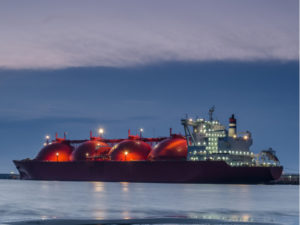
An LNG tanker docked at the terminal in Swinoujscie, Poland. By Wojciech Wrzesien @ Shutterstock.com
Natural gas is moved via pipeline or specialized liquified natural gas (LNG) tanker ship. In a normal winter, New England imports a lot of LNG via ships, but this year, much of the world’s seaborne natural gas, including loads of it from the United States, are headed toward Europe to replace the lost supplies of Russian gas. No problem, right? Pipelines can bring the abundant natural gas resources of the United States to its population centers in the northeast. Right? Not really. The reason for that is decades of environmentalist opposition to new pipelines to the northeast, while at the same time pushing the transition of electricity generation from coal to natural gas, forcing the limited supplies of gas coming into New England to be split between power generation and heating. So, while natural gas prices in the U.S. are coming down, and supplies in storage are going up, New England could still face supply shortages this winter. Ryan Dezember reports in The Wall Street Journal:
Natural-gas prices have fallen more than 40% since hitting shale-era highs in late August, reducing the risk of budget-busting heating bills this winter for millions of Americans and potentially easing a major cost pressure for manufacturers.
The decline is due to warm autumn weather, record domestic production and gas-storage facilities that have filled up fast since the end of air-conditioning season. Now, one of the big drivers of inflation costs roughly the same as it did a year ago.
Analysts warn that unusually cold weather could send prices soaring anew this winter, especially in the Northeast where maxed out pipelines have effectively capped output from Appalachia’s prolific producers.





